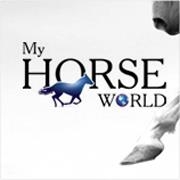Horsemanship Training Advanced Rider

The Advanced Rider course is divided into three sections:
• Riding Finished
• Hips-In
• Loping
Riding Finished is the most important thing for a rider to do. “Riding Finished” means to ride every horse as if he were the best horse you ever rode. Begin by assuming the horse is perfect and correct mistakes as they happen. Ask the horse for a response using the cue you would use on a finished horse, then correct as required. Because a horse will always go to the level of the rider, you need to raise his riding to your level not go down to his.
Our expectations of our horses are very important. If you don’t expect much of them, that is exactly what you’ll get. So the first thing you need to do is raise your expectations. Once you do, the horse will improve. This is the attitude a horse trainer, or any rider, needs.
Hips-In is the fourth and final of the foundational lessons. It is a three-track exercise that improves flexibility in the hindquarters and is one of the most important exercises for gaining control and improving performance. Hips-in does many things:
• Focuses on engaging and disengaging your horse’s hindquarters.
• Slows down a gait.
• Is useful in transitions and lead departures.
• Is a great warm-up exercise to get softness throughout a horse’s body.
Loping. When you begin teaching a young horse to lope, be a strong leader. You do not want him to fight or resist the bit. He needs to know that there is a release from the bit. To do this, spend time doing a relaxed lope with loose reins. If you don’t, you’ll end up spending too much time fighting for control of the horse’s head. When this happens the horse throws his head up every time you release the reins, so be light on the reins; use them only when you need to. Regardless of a horse’s age, you should begin loping him as soon as possible. If you avoid loping, it could lead to other problems.
A simple lead change occurs when a horse transitions from a jog or trot to a lope. To change leads with a simple change while loping, the rider transitions his horse down to a trot then picks up the opposite lead while making the transition back up to a lope. Good patterns to practice simple lead changes are a figure 8, serpentine, and a straight line.
In a flying lead change, one side of the horse moves faster than the other. If the horse is already moving fast, you need to slow one side down. In order for the change to happen effortlessly, your horse must be collected.
Company – LL Inc and the Lyons Legacy School of Horsemanship offer a wide variety of equine educational materials, including a series of horse training and riding courses, manuals, and videos for online and on-the-ground learning.
Contact – Ian Kirkham, LL Inc., ian.kirkham@gmail.com. A biologist with a PhD in animal behaviour, and a writer for much of his career, Ian now focuses on one of his lifelong passions – horses. He’s owned and trained horses in Canada, US, Zimbabwe and Costa Rica. Ian divides his time between training horses and creating educational products for horse lovers.
